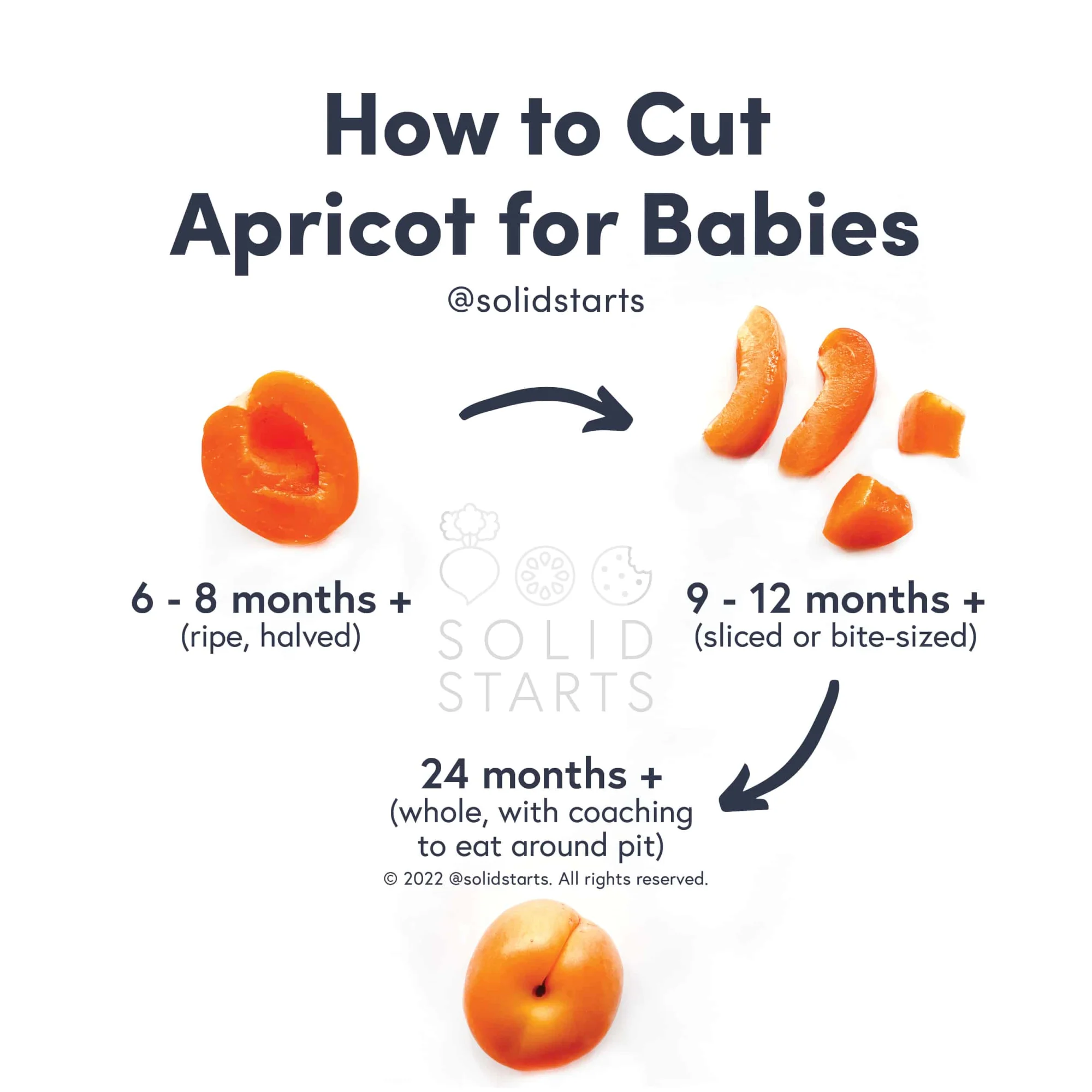Apricot
Fruit
Age Suggestion
6 months
Iron-Rich
No
Common Allergen
No

When can babies have apricots?
Apricots may be introduced as soon as baby is ready to start solids, which is generally around 6 months of age, as long as the fruit is very soft and ripe or cooked until soft.
Sun-kissed harbingers of warmer weather to come, apricot is one of the first stone fruits of the growing season to show up at markets. Unlike other stone fruit, apricot’s sweetness is balanced with a hint of acidity, a flavor combination that shines in savory cooking like Moroccan tagine or Pakistani biryani and adds nuance to sweets like Armenian doshab and Greek baklava.
Are apricots healthy for babies?
Yes. Apricots offer carbohydrates, fiber, and fluid, in addition to potassium and vitamins A, B6, C, E, and K. Together, these nutrients help provide energy to fuel baby’s movement and exploration, support the digestive system, and keep baby hydrated. They also help to support electrolyte balance, skin health, vision, metabolic processes, iron absorption, immune function, and blood clotting. Apricots and other stone fruits are particularly helpful for babies struggling with constipation.
Are apricots a common allergen?
No. Although serious allergic reactions to apricot have been reported, apricot is not considered to be a common food allergen. A history of severe reactions to other stone fruits in the absence of pollen allergy may increase the risk of serious apricot allergy. Individuals who are allergic to almonds and other fruit in the Rosaceae family (apple, pear, cherry, nectarine, and peach), or who have Oral Allergy Syndrome (also called pollen food allergy syndrome) may also be sensitive to apricots. Oral Allergy Syndrome typically results in short-lived itching, tingling, or burning in the mouth; it is unlikely to result in a dangerous reaction. Cooking and peeling the fruit may help reduce reactions for those who are sensitive.
As you would do when introducing any new food, start by offering a small amount during the first few servings. If there is no adverse reaction, gradually increase the amount served over future meals.
Are apricots a choking hazard for babies?
Yes. Apricots contain a hard pit inside and, especially when underripe, are slippery and can be firm, qualities that increase the risk of choking. To reduce the risk, prepare and serve apricots in an age-appropriate way as described in the How to Serve section. As always, make sure you create a safe eating environment and stay within an arm’s reach of baby during meals.
Learn the signs of choking and gagging and more about choking first aid in our free guides, Infant Rescue and Toddler Rescue.
Videos
Can babies eat dried apricots?
Dried fruit is a choking hazard as it is challenging to chew. If a recipe you’d like to share with baby calls for dried apricots, try rehydrating the fruit in warm water until it is completely soft, then finely chopping or pureeing the rehydrated fruit and mixing it into the dish.
How do you serve apricots to babies?
Every baby develops on their own timeline, and the suggestions on how to cut or prepare particular foods are generalizations for a broad audience.
6 months old +:
Offer baby a very ripe pitted apricot cut in half with the skin on. The fruit should be soft enough that it mashes readily when gently pressed between your thumb and pointer finger. Leaving the skin on helps baby grip the slippery fruit, but if the skin makes you nervous, peel it and roll the apricot half in shredded coconut or finely ground-up nuts or seeds to reduce slipperiness and to add grip. If baby bites off a big piece, take a deep breath and refrain from sticking your fingers in baby’s mouth. Instead, kneel down in front of baby, encouraging them to look down at you and allowing gravity to help move the food out of their mouth. Alternatively, mash the apricot and mix into a soft, easy-to-scoop food like porridge or yogurt.
9 months old +:
Offer thin slices of soft, ripe apricot with the skin on or off. The fruit should be soft enough that it mashes readily when gently pressed between your thumb and pointer finger. If baby is not ready to pick up slices of apricot, continue offering pitted apricot halves with the skin on or peeled. Because apricots are so slippery, bite-sized pieces may be too challenging for baby to pick up, but you can also try rolling small pieces in shredded coconut or finely ground-up nuts.
12 months old +:
Continue with ripe thinly-sliced apricots or halved, pitted apricots for biting practice. If the child puts the entire apricot half in their mouth, give them a minute to work with the food and then, if necessary, coach them on how to spit the food out. Alternatively, cut ripe apricot into bite-sized pieces to pre-load on a fork.
18 months old +:
Continue serving ripe, soft apricot in halves, slices, or bite-sized pieces. You can also try serving a whole dried apricot (pit removed) if you feel the child has developed the biting, tearing, chewing and swallowing skills needed to eat dried fruit. Dried fruit is a choking hazard so trust your gut and wait to serve whole dried apricot until you feel the child is ready and coach the child on how to take bites from each piece.
24 months old +:
If you feel comfortable, consider offering the child a whole apricot. We recommend you eat one at the same time to demonstrate biting into the apricot and how to avoid the pit. Take a few bites and then show the toddler the hard pit on the inside. Tap it with your finger and tell them “I am eating around this hard part.”
If the toddler puts the pit in their mouth, step one: do not panic. Remember that a pit can be safely swallowed whole or may engage a strong gag reflex to move it forward and out of the mouth. Kneel next to the toddler and demonstrate sticking your tongue out and say calmly: “Spit that out please.” Put your hand under their chin while you demonstrate. If needed, put a pit in your own mouth, show it on your tongue and demonstrate spitting it into your own hand.


How to prepare apricots for babies 6 months+
How to prepare apricots for babies 9 months+
Our Starting Solids virtual course answers all your questions about introducing babies to solid food.
Our Team
Written by
Expert Tips Delivered to Your Inbox
Sign up for weekly tips, recipes and more!
Copyright © 2024 • Solid Starts Inc






